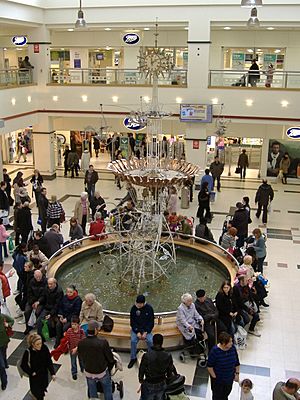Aqua Horological Tintinnabulator facts for kids
The Aqua Horological Tintinnabulator is a special 'water-powered' clock. It's also known as the Victoria Centre Clock, the Emett Clock, or The Time Fountain. From 1973 to 2010, it was located on the ground floor of the Victoria Centre in Nottingham, England. In 2015, this amazing clock was put back in the shopping centre, but this time on the first floor.
History of the Victoria Centre Clock
This unique clock was ordered in 1970 by a company called Capital and Counties. It was designed and built by a famous artist named Rowland Emett. He was known for making sculptures that moved. Construction of the fountain started on August 26, 1970. The clock was installed in late 1972, the same year the Victoria Centre opened. It was fully ready by February 20, 1973. A special stone at the clock's base says "THE VICTORIA CENTRE TIME FOUNTAIN FEBRUARY 20TH 1973 BY EMETT."
When it was first built, the clock played a piece of music by Jean-Philippe Rameau called "Gigue en Rondeau II." It played this music every hour and half hour. The clock parts were designed by Thwaites & Reed.
The clock stands 23 feet high, which is about as tall as a two-story building! It has become a very famous landmark in Nottingham. Between 1973 and 2010, people threw about £250,000 in coins into the fountain.
Bringing the Clock Back to Life
In November 2011, a local engineer named Pete Dexter noticed the clock wasn't working. He asked the shopping centre if he could look at it. They agreed, and Pete designed a new electrical system to make the clock's moving parts work again. He also brought back the original music, changing it from an old cassette tape system to a modern audio CD system.
In February 2014, Pete Dexter and technicians from the Victoria Centre carefully took the clock apart. They moved it to different places near Tamworth to begin fixing it up. Pete Dexter and the Rowland Emett Society worked on restoring many parts. For example, the clock's frame was put back to its original shape. They even added sections to make it taller by about 400mm (about 16 inches). This extra height was needed because parts of the legs had been cut off when the clock was moved before. The frame was painted back to its original grey-green colour. Pete also built a new mechanical system for the cobweb wheel, using old photos to guide him.
The clock was put together temporarily in Birmingham for an exhibition of Rowland Emett's art. After about three months, it was taken apart again and stored until December 2014. Then, all the parts were brought back to Nottingham. From January to June 2015, Pete Dexter and the Victoria Centre staff worked hard to finish the renovation.
Finally, the clock was put back together on the upper mall of the Victoria Centre. It was officially restarted on June 17, 2015. It now sits in a special new water basin. This basin has a new water system that brings back the original twelve water jets.
What Does the Clock Look Like?
The Aqua Horological Tintinnabulator has four shiny, silver-white clock faces with golden hands and numbers at the very top. Below the clock faces is an amazing moving sculpture. It features a large sunflower with 36 copper petals. These petals partly hide a small orchestra of six players. These players are made up of three squirrels and three birds, all decorated with jewels.
Every fifteen minutes, a bell rings, and then the clock performs! The sunflower petals slowly lower, showing the hidden players. The entire orchestra then spins around, and each player also spins on its own spot. The harpsichord music, "Gigue en Rondeau II," plays for about 75 seconds. After the music stops, the petals rise again, and the animation ends.
A large cobweb wheel, two metres wide, spins all day long. It has jeweled butterflies and frogs on it. Also, a "Top Feature" continuously rotates. This feature has three arms with jeweled decorations. One arm shows a squirrel riding a flying fish. Another has a squirrel pushing a pram with a bird's nest and birds above it. The third arm shows a peacock rowing a boat with a squirrel on the steering part. In the middle of the sculpture, there's a beautiful floral bouquet sitting on a big copper leaf, also decorated with jeweled birds. The clock used to perform only on the hour and half hour, but it was changed to perform every fifteen minutes.


